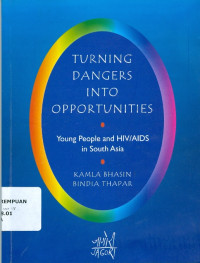
Text
Turning dangers into opportunities: Young People and HIV/AIDS in South Asia
Young people are at the centre of the global HIV/AIDS pandemic. They also are the world’s greatest hope in the struggle against this fatal disease. Today’s youth have inherited a lethal legacy that is killing them and their friends, their brothers and sisters, parents, teachers and role models. An estimated 11.8 million young people aged 15 to 24 are living with HIV/AIDS. Each day, nearly 6,000 young people between the ages of 15 and 24 become infected with HIV. Yet only a fraction of them know they are infected. More than two decades into the epidemic, the vast majority of young people remain uninformed about sex and sexually transmitted infections (STIs). Although a majority have heard of AIDS, many do not know how HIV is spread and do not believe they are at risk. Those young people who do know something about HIV often do not protect themselves because they lack the skills, the support or the means to adopt safe behaviours. Nonetheless, in areas where the spread of HIV/AIDS is subsiding or even declining, it is primarily because young men and women are being given the tools and the incentives to adopt safe behaviours. Young people have demonstrated that they are capable of making responsible choices to protect themselves when provided such support, and that they can educate and motivate others to make safe choices
Availability
| KP.IX.000187 | KP.IX BHA t | My Library | Available |
Detail Information
- Series Title
-
-
- Call Number
-
KP.IX BHA t
- Publisher
- New Delhi : Jagori., 2003
- Collation
-
x, 82p. : ill. ; 23cm.
- Language
-
English
- ISBN/ISSN
-
-
- Classification
-
KP.IX
- Content Type
-
-
- Media Type
-
-
- Carrier Type
-
-
- Edition
-
-
- Subject(s)
- Specific Detail Info
-
-
- Statement of Responsibility
-
-
Other version/related
No other version available
File Attachment
Comments
You must be logged in to post a comment
 Computer Science, Information & General Works
Computer Science, Information & General Works  Philosophy & Psychology
Philosophy & Psychology  Religion
Religion  Social Sciences
Social Sciences  Language
Language  Pure Science
Pure Science  Applied Sciences
Applied Sciences  Art & Recreation
Art & Recreation  Literature
Literature  History & Geography
History & Geography